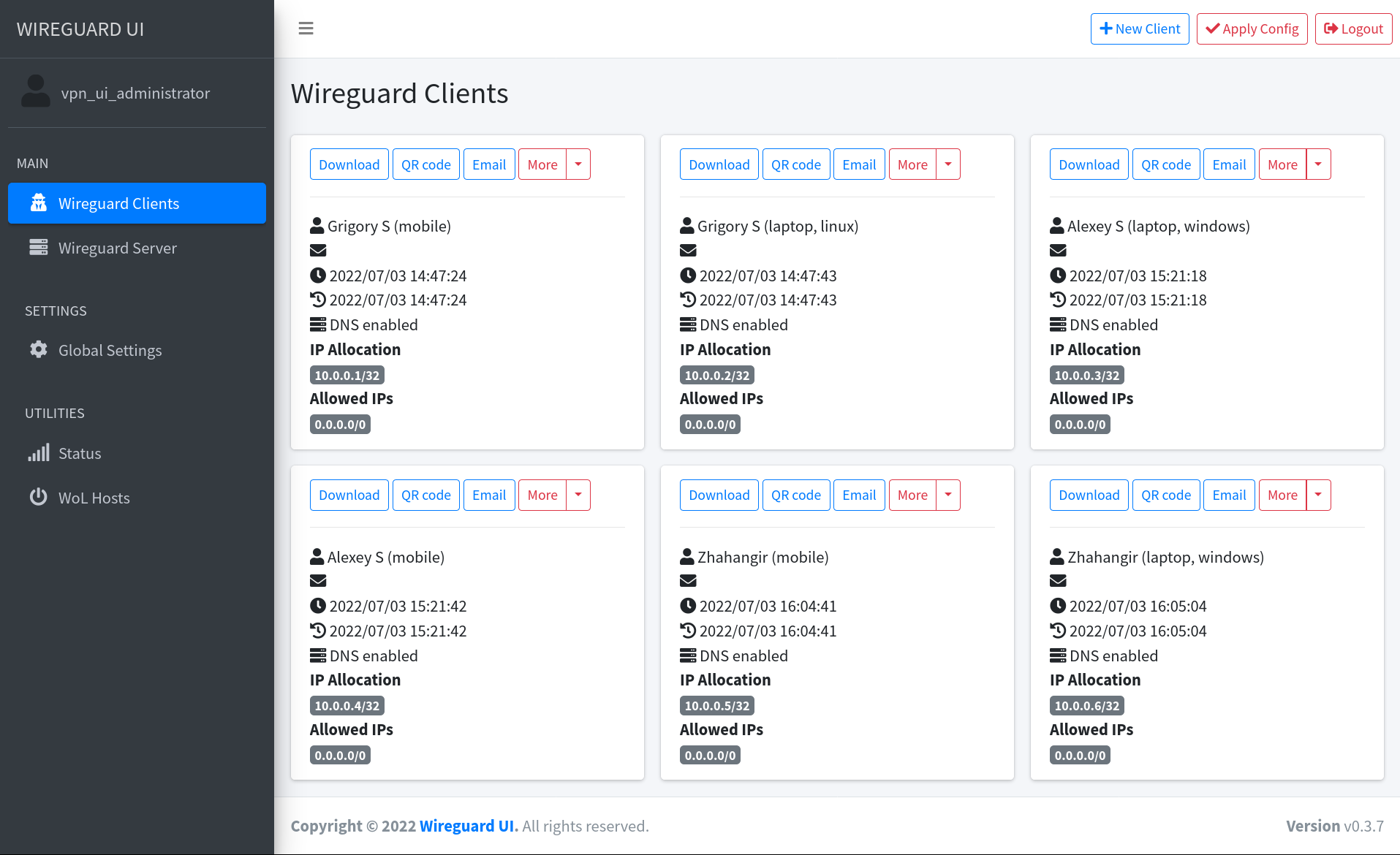9.3 KiB
wireguard-ui
A web user interface to manage your WireGuard setup.
Features
- Friendly UI
- Authentication
- Manage extra client information (name, email, etc)
- Retrieve configs using QR code / file
Run WireGuard-UI
Default username and password are admin.
Using binary file
Download the binary file from the release and run it with command:
./wireguard-ui
Using docker compose
You can take a look at this example of docker-compose.yml. Please adjust volume mount points to work with your setup. Then run it like below:
docker-compose up
Note:
- There is a Status option that needs docker to be able to access the network of the host in order to read the
wireguard interface stats. See the
cap_addandnetwork_modeoptions on the docker-compose.yaml - Similarly the
WGUI_MANAGE_STARTandWGUI_MANAGE_RESTARTsettings need the same access, in order to restart the wireguard interface. - Because the
network_modeis set tohost, we don't need to specify the exposed ports. The app will listen on port5000by default.
Environment Variables
| Variable | Description |
|---|---|
SESSION_SECRET |
Used to encrypt the session cookies. Set this to a random value. |
WGUI_USERNAME |
The username for the login page. (default admin) |
WGUI_PASSWORD |
The password for the user on the login page. Will be hashed automatically. (default admin) |
WGUI_PASSWORD_HASH |
The password hash for the user on the login page. (alternative to WGUI_PASSWORD) |
WGUI_ENDPOINT_ADDRESS |
The default endpoint address used in global settings. (default is your public IP address) |
WGUI_DNS |
The default DNS servers (comma-separated-list) used in the global settings. (default 1.1.1.1) |
WGUI_MTU |
The default MTU used in global settings. (default 1450) |
WGUI_PERSISTENT_KEEPALIVE |
The default persistent keepalive for WireGuard in global settings. (default 15) |
WGUI_FORWARD_MARK |
The default WireGuard forward mark. (default 0xca6c) |
WGUI_CONFIG_FILE_PATH |
The default WireGuard config file path used in global settings. (default /etc/wireguard/wg0.conf) |
BASE_PATH |
Set this variable if you run wireguard-ui under a subpath of your reverse proxy virtual host (e.g. /wireguard)) |
Defaults for server configuration
These environment variables are used to control the default server settings used when initializing the database.
| Variable | Description |
|---|---|
WGUI_SERVER_INTERFACE_ADDRESSES |
The default interface addresses (comma-separated-list) for the WireGuard server configuration. (default 10.252.1.0/24) |
WGUI_SERVER_LISTEN_PORT |
The default server listen port. (default 51820) |
WGUI_SERVER_POST_UP_SCRIPT |
The default server post-up script. |
WGUI_SERVER_POST_DOWN_SCRIPT |
The default server post-down script. |
Defaults for new clients
These environment variables are used to set the defaults used in New Client dialog.
| Variable | Description |
|---|---|
WGUI_DEFAULT_CLIENT_ALLOWED_IPS |
Comma-separated-list of CIDRs for the Allowed IPs field. (default 0.0.0.0/0) |
WGUI_DEFAULT_CLIENT_EXTRA_ALLOWED_IPS |
Comma-separated-list of CIDRs for the Extra Allowed IPs field. (default empty) |
WGUI_DEFAULT_CLIENT_USE_SERVER_DNS |
Boolean value [0, f, F, false, False, FALSE, 1, t, T, true, True, TRUE] (default true) |
WGUI_DEFAULT_CLIENT_ENABLE_AFTER_CREATION |
Boolean value [0, f, F, false, False, FALSE, 1, t, T, true, True, TRUE] (default true) |
Docker only
These environment variables only apply to the docker container.
| Variable | Description |
|---|---|
WGUI_MANAGE_START |
Start/stop WireGaurd when the container is started/stopped. (default false) |
WGUI_MANAGE_RESTART |
Auto restart WireGuard when we Apply Config changes in the UI. (default false) |
Email configuration
To use a custom wg.conf template, set the WG_CONF_TEMPLATE environment variable to a path to such file. To make sure wireguard-ui will be able to work with it - refer to the default template.
In order to send the wireguard configuration to clients via email, set the following environment variables:
- using SendGrid API
SENDGRID_API_KEY: Your sendgrid api key
EMAIL_FROM_ADDRESS: the email address you registered on sendgrid
EMAIL_FROM_NAME: the sender's email address
- using SMTP
SMTP_HOSTNAME: The SMTP ip address or hostname
SMTP_PORT: the SMTP port
SMTP_USERNAME: the SMTP username to authenticate
SMTP_PASSWORD: the SMTP user password
SMTP_AUTH_TYPE: the authentication type. Possible values: PLAIN, LOGIN, NONE
SMTP_ENCRYPTION: the encryption method. Possible values: SSL, SSLTLS, TLS or STARTTLS (default)
EMAIL_FROM_ADDRESS: the sender's email address
EMAIL_FROM_NAME: the sender's name
Auto restart WireGuard daemon
WireGuard-UI only takes care of configuration generation. You can use systemd to watch for the changes and restart the service. Following is an example:
systemd
Create /etc/systemd/system/wgui.service
cd /etc/systemd/system/
cat << EOF > wgui.service
[Unit]
Description=Restart WireGuard
After=network.target
[Service]
Type=oneshot
ExecStart=/usr/bin/systemctl restart wg-quick@wg0.service
[Install]
RequiredBy=wgui.path
EOF
Create /etc/systemd/system/wgui.path
cd /etc/systemd/system/
cat << EOF > wgui.path
[Unit]
Description=Watch /etc/wireguard/wg0.conf for changes
[Path]
PathModified=/etc/wireguard/wg0.conf
[Install]
WantedBy=multi-user.target
EOF
Apply it
systemctl enable wgui.{path,service}
systemctl start wgui.{path,service}
openrc
Create and chmod +x /usr/local/bin/wgui
cd /usr/local/bin/
cat << EOF > wgui
#!/bin/sh
wg-quick down wg0
wg-quick up wg0
EOF
chmod +x wgui
Create and chmod +x /etc/init.d/wgui
cd /etc/init.d/
cat << EOF > wgui
#!/sbin/openrc-run
command=/sbin/inotifyd
command_args="/usr/local/bin/wgui /etc/wireguard/wg0.conf:w"
pidfile=/run/${RC_SVCNAME}.pid
command_background=yes
EOF
chmod +x wgui
Apply it
rc-service wgui start
rc-update add wgui default
docker
Set WGUI_MANAGE_RESTART=true to manage Wireguard interface restarts.
Using WGUI_MANAGE_START=true can also replace the function of wg-quick@wg0 service, to start Wireguard at boot, by running the container with restart: unless-stopped.
These settings can also pick up changes to Wireguard Config File Path, after restarting the container.
Build
Build docker image
Go to the project root directory and run the following command:
docker build -t wireguard-ui .
Build binary file
Prepare the assets directory
./prepare_assets.sh
Then you can embed resources by generating Go source code
rice embed-go
go build -o wireguard-ui
Or, append resources to executable as zip file
go build -o wireguard-ui
rice append --exec wireguard-ui
Screenshot
License
MIT. See LICENSE.
Support
If you like the project and want to support it, you can buy me a coffee ☕
